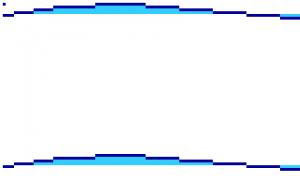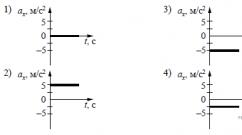Laminator - equipment for making documents protective and presentable. How to choose an A4 laminator - recommendations and reviews
Laminator- equipment designed to cover printed materials and various important documents with a special protective plastic film. The process of rolling a document into film using a laminator is called lamination or lamination.
Lamination is applicable in a wide variety of areas - in printing, design and advertising activities, in the manufacture of business cards, passes and certificates, as well as in the design of various photo compositions.
The main task of lamination is to protect printed products from mechanical damage and negative impact. environment... In addition, a document that has passed the lamination procedure additionally acquires a number of advantages. So, a document protected with a special film makes it more difficult to counterfeit, and also acquires a more presentable appearance and becomes more rigid.
Everything large quantity people give Special attention image design of documentation. In specialized lamination centers and printing houses there is no end to customers.
In the meantime, the most discerning people choose to buy their own laminator. This saves not only time, but also money!
The difficulty is that in a wide range of laminating devices it is not very easy to make a choice. In order to buy a laminator exactly the one that would be perfect for the tasks at hand, you need to understand everything "from and to".
By type of use Supplies laminators are divided into two types.
Batch laminator
Batch laminators operate with film pre-formatted to a specific size. Such films are called bags (envelopes), hence the name - packet laminator. In turn, batch laminators are divided into two categories - office and professional.
An office batch laminator typically uses a hot plate heating system, more often external heating rolls. This type is intended for small volumes of home or office tasks. They have a fairly simple intuitive control. Some models are equipped with temperature control and laminating speed, as well as a reverse function. The performance of such devices is low and, after intensive use, the office laminator must be allowed to "catch its breath". Devices of this type have various formats - A6, A5, A4.
The professional batch laminator is designed for heavier workloads. Able to work continuously, without intermediate stops. Moreover, some models are equipped with an additional cooling source. The internal hot roll heating system gives an excellent lamination result. Some models of professional laminators have an LCD display with the display and setting of the exact parameters of the lamination.

Roll laminator
Roll laminators are used in professional printing centers and salons, as well as wherever it is necessary to laminate large volumes of printing products. The main advantage of this type of equipment is that the consumable material (roll film) is relatively inexpensive, and the productivity is many times higher than the productivity of the "bag".
It should be borne in mind that only a specially trained employee can handle the maintenance of the roll laminator, because it is necessary to adjust the film tension, temperature and pressure level of the rollers, as well as a number of other important parameters that can affect the quality of the laminated product.

Depending on the used temperature regime there are two types of lamination - hot and cold.
At the heart of hot lamination the principle lies different temperatures lamination. At a temperature above the melting point of the adhesive layer, but below the melting point of the plastic film itself, the glue diffuses (is transferred, spreads) into the texture of the paper. The process of thermal diffusion is additionally accompanied by the pressure of the rolls, as a result of which the film “grows into the paper”. This method is used for materials capable of retaining their properties under the influence of high temperatures.
At cold lamination when the possibility of heating is limited by the temperature sensitivity of the laminated material, it is necessary to be limited solely by the pressure of the rolls on the document. In this case, the film is glued to the product using different types adhesive base. Cold lamination is suitable for plastics, papers with glossy surfaces, as well as materials with high degree ink paints.
Depending on the type of heating system, laminators are divided into three categories:
Hot plate laminators. The design of this type of laminating machine consists of hot plates located inside the body of the laminator, usually at the top and bottom in relation to the laminated document, and two cold rollers at the inlet and outlet.
Heat transfer from hot plates to the film in such laminators is carried out due to the gaps on both sides between the laminated document and the actual plates. Finding a blank document when passing through the plates can be compared to the effect of a “stove” and despite the fact that the document is additionally rolled with a cold roll at the exit, the lamination result leaves much to be desired.
The problem lies in the fact that heating is carried out through the air space and, as a result, does not spread evenly. Due to this, the surface of the document becomes wavy and air bubbles. Hot plate laminators are still on the market but have been abandoned by many manufacturers.
Hot roll laminators (internal heating). Laminators with internal heating rolls are expensive professional equipment, capable of continuously performing the tasks they face.
This type of shaft heating system uses a heater in the form of a nichrome spiral placed in a quartz cylinder, which heats directly from the inside of the shaft.
The possibilities of hot roll laminators are endless. With their help, you can laminate photographs, produce foil stamping for powder printing (foiling), as well as matting and glossing of powder printing.
Pressing with hot rollers at the exit from the laminator ensures the penetration of the adhesive layer of the film into the surface of the document at every point of its area, which has a positive effect on the quality of lamination.
Laminator with external heated rolls (pseudo hot rolls)... This type of laminator is an "economical" type of laminator with a system of internal heating rolls and is the most demanded. However, this does not affect the quality of the lamination in any way. The only difference from professional models is the impossibility of continuous work. After 40-50 minutes of work, they need to "rest" for 15-20 minutes.
The shafts are located in a special cylinder with a built-in heating element - a nichrome spiral, which carries out external heating of the shafts. As well as laminators with internal heating rollers, they can foil, mat, gloss and laminate photographs.
An important element- reverse function
Reverse is a structural part that allows you to change the direction of movement of the shafts of the laminator in reverse side... This is the most important parameter, the presence of which must be taken into account when buying a batch laminator.
Why is the reverse function so important? The answer is simple. This function allows you to insure the laminated document against jams and jams, and as a result of its damage. Jams and jams of the laminated workpiece occur by winding the workpiece onto the shafts of the laminator. As a rule, this happens due to the inexperience of the operator, having incorrectly guided the batch blank into the receiving hole. But it also happens that its winding on the shafts occurs due to their banal contamination during operation.
Just at the moment when the blank from the film and the document has gone crooked, or is already inside the laminator, and the reverse function, irreplaceable in this case, comes to the rescue.
It is worth noting that in those models where they saved due to this function, as a rule, there is a function to release the document. By pressing the dedicated button or toggle switch, the laminator shafts are unclenched, and the document is released.
In some models, the developers provide an anti-jam function. A laminator with this function almost completely eliminates the possibility of winding the workpiece on the shafts.
Lamination temperature control
With the function of selecting a certain temperature regime of the rollers, the laminator is able to work with various thicknesses of films. However, it is impossible to find the right temperature for lamination of this or that film without certain skills. For beginners experiencing this function for the first time, this usually happens by the method of selection.
Laminator format
Considering that the lamination material is paper products, when choosing a laminator, you must first take into account its format.
Very often there is a situation when there is already an A6 or A5 laminator, and it is required to laminate an A4 document. But, for obvious reasons, unfortunately this cannot be done and the owners of small format laminators have to buy a second larger format laminator.
In order not to get into such a situation, experts recommend purchasing one laminator, but of the format that would suit you for laminating documents of various sizes.
Use for any purpose, publication on the Internet
and print media, as well as copying of materials is allowed
exclusively by agreement with the administration of the resource site!
Lamination called the coating process printed sheet plastic. The document is sealed into a double-sided bag made of special laminating film, under the influence of heat transmitted from the heating element of the laminator. Lamination refines products, protects against dirt, water, mechanical damage, protects against counterfeiting, and also increases the color and brightness of laminated documents. Another valuable feature of lamination is image enhancement. When using glossy films, the image "appears" - the colors become more colorful and contrasting.
Laminator, in turn, it is a lamination machine.
Front choice of laminator you need to find some nuances for yourself, such as:
By type of heating system:
Hot plate laminators.
The workpiece in the film passes through a narrow gap between the oven plates. The film is rolled onto the workpiece with cool rubber rollers at the exit. From time to time, the stove is placed between 2 pairs of cool shafts. The low result of lamination is justified by the fact that heat transfer from the plates to the film occurs by the emission method through the air gap.
The presence of such a technologically determined gap causes uneven heating and deformation of the film, the complexity of the selection of a rational temperature regime and its inconstancy. Cool rollers installed at the exit from the oven take away the heat transferred to the film in the oven, preventing the polymer binder from combining with top layer paper in a proper way. The finished product comes out with air bubbles, wavy, poorly resistant to mechanical stress.
Manufacturers demand the unavoidable use of a cardboard sleeve for lamination in order to somehow reduce the trivial flaws of this technology and protect the document from possible damage. At the real moment, all the leading manufacturers have practically completely abandoned this outdated system and switched to the production of laminators with hot external heating rollers.
Hot roll laminators.
To heat such shafts, an internal heater in the form of a spiral is used, made of nichrome wire, electrically insulated from the shaft by means of a quartz tube, into which it is placed.
The introduction of this technology has led to the emergence of a whole family of series of profiled laminators.
A fascinating feature of hot roll laminators is their additional capabilities, making these machines truly universal tools, which allows them to be used in different sectors of the service market, document flow and small printing industry. These include such as the possibility of embossing with toner-sensitive foil for powder printing, glossing and, accordingly, matting of powder printing, etc.
Laminators with external cumulative heating ("hot roll effect").
Affordable units with one pair of hot rolls. The shafts are heated from the outside using a special cylindrical sector with an integrated nichrome heater. They allow you to make high-quality lamination of both everyday documents and photos, foil stamping for powder printing. The function of hot rolls remained, but the price of new devices became affordable not only for companies, but also for personal users.
Some of the latest laminators deserve special attention GMP in which a clay heater with ruthenium antioxidant protection is used. The new heating element, due to the low price of ceramics in comparison with metal, made it possible to make a new the lineup machines with hot shafts at the cost of ordinary ones. For laminators of this class, the heating time is significantly reduced (by 2-3 times), the accuracy of temperature control is significantly increased.
By the method of using consumables:
Batch laminators.
A batch laminator, unlike a roll laminator, works with films of ready-made formats: from the smallest (for badges and business cards) to A2 format. Most often, the film is not cut into sheets, but "packets", which are two sheets folded together with an adhesive layer to each other and glued on one side (most often narrow). The exception is films for cool lamination, which are cut into sheets, as they are usually provided for one-sided lamination.
Batch laminators, in turn, are divided into office and professional series.
Package laminator design office series pretty common. The heating element is either plates or shafts with external heating. Office laminators are designed for small volumes of work in the monastery or in a small office and are characterized by fairly conventional controls. Some laminators are equipped with temperature control, which provides the possibility of introducing films of a wide range of thicknesses, a "reverse" function to stop the lamination process and return the document, allowing you to correct possible operator errors.
Laminators professional series designed for richer work with a wider range of materials. They are built according to the scheme: 4 or 6 shafts, which are heated from the inside, such a scheme provides the best quality lamination and foiling. Certain models of the A3 format are equipped with an LCD display for convenience and accuracy of options, a "reverse" function and an adjustable lamination speed to ensure the highest productivity when working with a full range of materials. Consumables represent a bag of various formats, sealed on one side, inside which a document is laid and passed through a laminator. Working on a batch laminator does not require any special abilities. These are all trivial benefits.
The cons are also obvious:
Roll laminators process posters from A3 to A0 and can be used in enterprises with large volumes of lamination of documents or to perform services in print shops. In addition, some models of laminators allow you to create one-sided lamination and foil stamping.
The benefits of this method:
By the presence / absence of reverse:
At first, due to the lack of work experience, and in the future, due to contamination of the shafts, winding of the lamination blank on the shafts may occur. V in this case there is no longer any ability to save the document, because even turning off the laminator does not lead to lightning-fast cooling of the heaters. Seizure of a document often requires practically complete disassembly apparatus, which for some manufacturers is thoughtlessly associated with the dismantling of the engine, the drive gearbox, and then the shaft fastening system. And all this for the sake of retrieving the first irrevocably lost document. It is much easier, by pressing the reverse button, to return everything to its initial state, saving the document. The reverse function is usually only available on A4 and larger laminators.
By lamination formats:
As mentioned above, batch laminators work with A6-A3 formats, roll laminators - with A3-A0 formats. Many future users, trying to save a little, purchase small format laminators, wrongly believing that they will never need to laminate a large format, and small formats cannot be laminated on a large laminator. The larger the laminator, the more convenient it is to work, the higher its productivity. It is not uncommon for the workpiece to move out of place due to improper placement in the lamination slot, causing edge jams and damage to the document. On the contrary, in that case, the format of the blanks is rather small, it is possible to skip a few blanks at a time, laying them alternately across the entire width of the laminator. Larger format laminators are more meaningful in design, because the manufacturer is not chasing lower prices. It is necessary to keep in mind that a good laminator will serve for a very long time and it is hard to imagine what kind of work will need to be done in a couple of years.
Primary sources:
A laminator is an equipment designed to protect information from mechanical damage. There are many modifications and types of laminators. They should be chosen based on many criteria, including the working volume, price, purpose, cost of consumables, and so on. Lamination is the process of rolling a document or photograph into film, which significantly extends their service life and protects them from mechanical damage. wide application with the spread souvenirs... Such postpress has long and firmly entered into use in many areas of printing, in design and decoration. Until a few decades ago, the lamination procedure was available only to large printing companies. The protective material was made from solvent glue and solvents. With this solvent-based lamination process, several days had to pass before the glue cured and the material could be used. It was expensive and time consuming. Only in last quarter In the twentieth century, the production of solvent-free adhesives was started, which did not require solvents. With it, there was no need to install special drying systems, which led to significant savings in time and money. There are several types of laminators. Depending on the heating system, a distinction is made between hot plate laminators and laminators with external or internal heating rolls. In cold roll laminators, the laminating film is rolled onto the workpiece at the exit. This technology gives poor results. Therefore, this system is considered obsolete. Gradually, all firms are switching to the use of laminators with external hot rolls in their production. In such machines, the roll rotates inside the oven and accumulates heat as it rotates. At the moment of rolling the film, heat is transferred to the workpiece. In the more expensive models, two additional shafts are installed, which improves the quality of the lamination. The quality of these products is high enough to be suitable for laminating photographs and any other high gloss surfaces. The price of such laminators has become quite affordable, so that any photo studio, even the smallest, can afford them. Distinguish between roll laminators and batch laminators. They differ in lamination method and format. The design of batch laminators is much simpler. A roll feed mechanism is not required there; neither a film tension system nor silicone rollers are needed. The result of the work of batch laminators is laminated sheets of various formats. In roll-to-roll laminators, these are rolls that are cut by special machines or a special knife. Consumables are a pack in the case of packet laminators and film rolls in the case of roll-to-roll laminators. Despite the fact that roll-fed laminators are more expensive, consumables are much cheaper. Laminators differ not only in design, price and consumables, but also in the circulation for which they are intended. Batch laminators are designed for short runs, sometimes no more than one document per shift. Roll laminators are equipment for printing houses and printing departments. Their use is cost-effective only for large circulations. Thus, a laminator is an equipment designed to protect information from mechanical damage. There are many modifications and types of laminators. They should be chosen based on many criteria, including the working volume, price, purpose, cost of consumables, and so on.
Laminators are machines that cover documents with a transparent plastic film, which for a long time protects them from external mechanical influences, retains a pleasant appearance, and also gives the image on paper even more brightness and contrast.
The lamination process in many offices, copy centers and printing houses has become simply irreplaceable, so in those places where there is a constant workflow, you can see a laminator. There are devices in different price categories. There are models that can be used even at home. Due to the active development of business in our country, a huge range of laminators has appeared. Choosing the right one has become much more difficult, so we'll try to steer you in the right direction so that you can choose your laminating machine wisely.
In this article we will devote you to the problem of choosing a laminator, tell you about the principle of its operation, characteristics, parameters that are important factors when buying.
What are laminators
Before you think about buying, you need to decide what type of laminator you need. They are of two types - roll and batch. They also differ in properties - cold and hot. Professionals working in printers and copy centers choose roll laminators. However, some manufacturers have started to produce professional series of bag lamination machines, which can also be found often in the printing industry.
Batch laminators
Batch laminators are used when it is necessary to cover standard format documents with film: from business cards to A3 format. Devices of the a5-a6 format perfectly cope with the production of passes and badges, for offices and relatively small print organizations- formats packet laminators a4, a3. If you need to make image products, then among the various machines you can find those that use hot rolls to perform foil stamping.
The main advantages of this type of laminating machine are affordable price and easy to use. Dealing with the controls with this machine will not be difficult even for those who see it for the first time. The heating tool is hot plates or externally heated rolls that prevent regular use of the laminating machine. Looking to buy a powerful and reliable batch laminator? Look for it in professional series.
What are the advantages of this type of machine:
- The lamination speed can be adjusted
- Shaft temperature can be set
- There is a reverse function
- High performance and reliability
All the benefits will provide high quality lamination and optimal results when using different types Supplies.
Rolled large format laminators
Roll laminating machines are used in professional printing houses, print shops and copy centers. These industrial laminators can handle documents in formats larger than A3.
Advantages:
- Double-sided lamination of documents depending on the model
- Foil stamping
- Low cost of consumables
- High productivity allowing for the production of large quantities of products
High product quality is achieved by heating rollers. The cost of such a machine is great, so trust the products of trusted brands. If you do not know which ones, we will advise you. Just give us a call.
Popular and proven brands of laminators that you can buy in our online store
| aurora | gbc | prolamic |
| excelam | gmp | sigma |
| fellowes: mars, saturn | kdfm | tiko |
| fgk: 120, 220, 320, etc. | pda | ico |
| fujipla lpd | pro | cosmic a4 |
Functions and properties of laminators
Today, the range of laminators is so wide that a common user will not immediately distinguish the special features of each device and the usefulness of its functions. To optimize your work, you will be helped not only by basic functions, but also by additional ones, such as reverse, regulation of the temperature of the heating element, as well as the speed of drawing the workpiece. Each function is aimed at processing documents of certain formats.
Reverse- an indispensable function for those who are not yet quite confident in using the A4, A3 batch laminator. It happens that due to insufficient maintenance of the shafts, winding of the workpiece may occur. Then, to retrieve the document, it will be necessary to completely disassemble the laminator, which will be difficult to accomplish without the help of a specialist. But even if you manage to disassemble the device and pull out the document, it will be impossible to save its original appearance. The reverse function is designed just for such cases. One push of a button, and the workpiece comes back without deformation or damage.
Laminator format... Many users do not attach the format of particular importance... Although, when choosing this, you also need to pay attention. Experts advise taking machines that are larger than the required format. For example, if you need to laminate the A5 format, then take an A4 laminator in reserve.
Temperature control allows the laminator to work with different film thicknesses for optimal results.
In custody
Choosing office equipment is a laborious process that requires a detailed approach. If you have any questions, call us - our specialists will give you complete and reliable information, and you can buy a laminator that will completely satisfy you in terms of price and quality.













